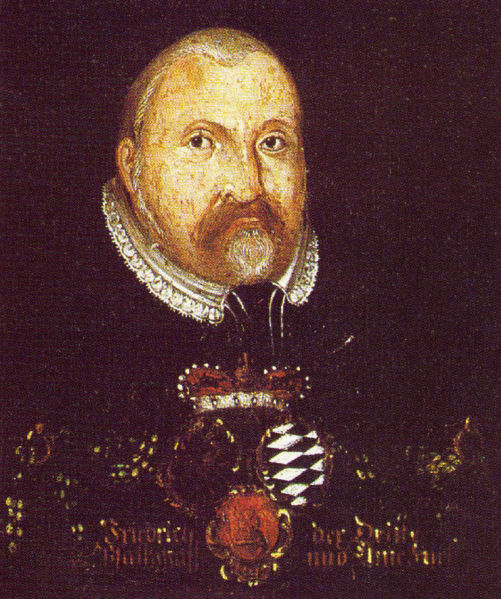<Back to Index>
- Demographer Thomas Robert Malthus, 1766
- Dramatist Pierre Claude Nivelle de La Chaussée, 1692
- Elector Palatine Frederick III of Simmern, 1515
PAGE SPONSOR

Frederick III of Simmern, the Pious, Elector Palatine of the Rhine (February 14, 1515 – October 26, 1576) was a ruler from the house of Wittelsbach, branch Palatinate - Simmern - Sponheim. He was a son of John II of Simmern and inherited the Palatinate from the childless Elector Otto - Henry, Elector Palatine (Ottheinrich) in 1559. He was a devout convert to Calvinism, and made Calvinism the official religion of his domain. Under his supervision the Heidelberg Catechism was constructed. His support of Calvinism gave the religious sect a foothold within the Holy Roman Empire.
He was strictly educated in the Roman faith at his father's court and at Cologne, but, influenced by his wife, the pious princess Maria of Brandenburg, whom he married in 1537, he followed the Reformation, and in 1546 made a public profession of his faith. He succeeded his father John II as duke of Simmern, May 18, 1557, and became elector February 12, 1559, on the death of Otto Henry. Under his predecessor strict Lutherans like Tilemann Heshusius, Melanchthonians, and Calvinists had found a place in the Palatinate. In the summer of 1559 bitter controversies arose among them. Theses on the Lord's Supper prepared by the Heidelberg deacon Wilhelm Klebitz provoked a bitter controversy between him and Heshusius.
When efforts at mediation failed Frederick deposed both, September 16. To get a clear understanding of the controversy Frederick spent days and nights in theological studies and was thus led more and more to the Reformed confession. A disputation held in June, 1560, between the Saxon theologians Johann Stössel and Joachim Mörlin and the Heidelberg Pierre Boquin, Thomas Erastus, and Paul Einhorn increased Frederick's dislike for the Lutheran zealots. After the Naumburg Convention (January, 1561) Frederick fully adopted the Reformed dogmas.
In March, 1561, he called Emmanuel Tremellius, and in September the famous Zacharius Ursinus, to Heidelberg. The whole Church was now transformed. Caspar Olevianus had been there since January, 1560. Images of the saints, vestments, baptismal fonts, and other "idolatrous works," even organs, were ruthlessly removed from the churches. In the celebration of the Lord's Supper the breaking of bread was introduced. The revenues from monasteries and foundations were confiscated and applied to Evangelical church purposes or charity. The Heidelberg Catechism, prepared a committee of theologians and ministers likely led by Ursinus, now served as the norm of doctrine and for the instruction of the youth.
The church - order of November 15, 1563, and the consistory order of 1564 consolidated the changes. The opposition of ministers inclining to Lutheranism was suppressed by their dismissal. Among the Lutherans Frederick's measures caused a great sensation. The religious colloquy held at Maulbronn, April, 1564 increased the animosity. In 1565 the Emperor Maximilian ordered to annul the changes made. A unanimous decree of the diet held at Augsburg in 1566 also demanded the abolition of the changes. Frederick, however, declared in a session of the diet, May 14, that a matter was concerned over which God alone has the rule, and if it was intended to proceed against him, he would find comfort in the promises of his Savior. The decree was not carried out.
After completing the work of reform in the Rhine Palatinate Frederick endeavored to continue it in the Upper Palatinate; but here he was resisted by the zealous Lutheran estates. He continued his work of reform on the Rhine by introducing in 1570 a strict church discipline. Frederick pronounced the sentence of death on the Antitrinitarian Johann Sylvan based on the opinion signed by Olevianus, Ursinus, and Boquin, December 23, 1572.
In 1562 he gave Frankenthal for a refuge to the Evangelicals driven from the Netherlands. His like - minded son Johann Casimir he sent in 1567 and again in 1576 to France in aid of the Huguenots. In 1569 he assisted also the Count Palatine Wolfgang of Pfalz - Zweibrücken on
his way to France. His last years were troubled by domestic
afflictions. As his older son Louis was a strict Lutheran, he could not
hope that after his death his work would be carried out in his own
spirit. Frederick III was married twice. Firstly, he married in 1537 Marie of Brandenburg - Kulmbach (1519 – 1567), daughter of Casimir, Margrave of Brandenburg - Bayreuth and Susanna of Bavaria. They had 11 children. Secondly, he married in 1569 Amalia of Neuenahr (1539 – 1602), but this marriage was childless. He died in 1576, and was succeeded as Elector Palatine by his son Louis VI. Frederick had carved out a territory from the Lower Palatine land dubbed "Pfalz - Lautern" for his second surviving son Johann Casimir as
an enclave to enable the continued existence of the Reformed faith.
Johann Casimir would serve as regent for the Electoral Palatinate upon
Louis VI's death and would oversee the return of the Reformed faith to
the Palatinate.